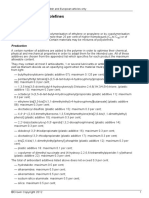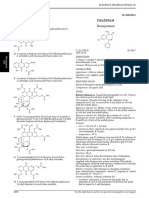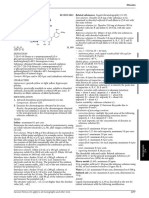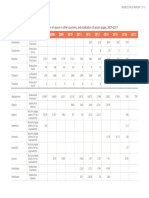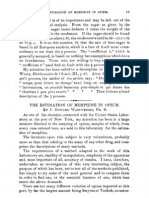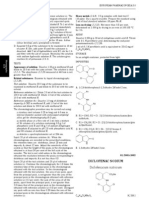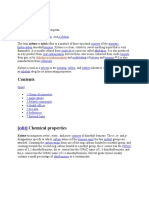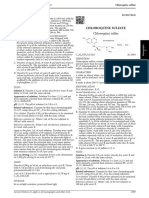Tramadol Hydrochloride
Tramadol Hydrochloride
Uploaded by
NurFauziahKasimCopyright:
Available Formats
Tramadol Hydrochloride
Tramadol Hydrochloride
Uploaded by
NurFauziahKasimOriginal Description:
Copyright
Available Formats
Share this document
Did you find this document useful?
Is this content inappropriate?
Copyright:
Available Formats
Tramadol Hydrochloride
Tramadol Hydrochloride
Uploaded by
NurFauziahKasimCopyright:
Available Formats
EUROPEAN PHARMACOPOEIA 5.
Tramadol hydrochloride
Microbial contamination. Total viable aerobic count (2.6.12) Optical rotation (2.2.7) : 0.10 to + 0.10, determined on
not more than 104 micro-organisms per gram, determined by solution S.
plate count. It complies with the tests for Escherichia coli
Impurity E. Thin-layer chromatography (2.2.27).
and Salmonella (2.6.13).
Test solution (a). Dissolve 0.10 g in methanol R and dilute
to 2 ml with the same solvent.
STORAGE
Test solution (b). Dilute 1 ml of test solution (a) to 10 ml
Store protected from light.
with methanol R.
LABELLING
Reference solution (a). Dissolve 25 mg of tramadol
The label states whether or not the contents are suitable for hydrochloride CRS in methanol R and dilute to 5 ml with
the same solvent.
preparing emulsions.
Reference solution (b). Dissolve 5 mg of tramadol
impurity E CRS in 5 ml of methanol R. Dilute 1 ml of the
01/2005:1681 solution to 10 ml with methanol R.
Reference solution (c). Dissolve 5 mg of tramadol
impurity A CRS in 1 ml of reference solution (a).
TRAMADOL HYDROCHLORIDE
Plate : TLC silica gel F254 plate R, prewashed with
methanol R.
Tramadoli hydrochloridum
Mobile phase : concentrated ammonia R, 2-propanol R,
toluene R (1:19:80 V/V/V).
Application : 10 l.
Development : over 2/3 of the plate. Saturate the plate
for 20 min with concentrated ammonia R. For this, add
concentrated ammonia R to one trough of a twin trough
tank. Just before developing, add the mobile phase to the
other trough. Place the plate in the chromatographic tank,
ensuring that the layer of silica gel is orientated towards the
middle of the tank.
Drying : in air.
C16H26ClNO2
Mr 299.8 Detection : expose the plate to iodine vapour for 1 h, examine
in ultraviolet light at 254 nm.
DEFINITION
System suitability : the chromatogram obtained with
(1RS,2RS)-2-[(Dimethylamino)methyl]-1-(3reference solution (c) shows 2 clearly separated spots.
methoxyphenyl)cyclohexanol hydrochloride.
Limit : in the chromatogram obtained with test solution (a) :
Content : 99.0 per cent to 101.0 per cent (anhydrous
impurity E : any spot corresponding to impurity E is
substance).
not more intense and not greater than the spot in the
chromatogram obtained with reference solution (b)
CHARACTERS
(0.2 per cent).
Appearance : white, crystalline powder.
Related
substances. Liquid chromatography (2.2.29).
Solubility : freely soluble in water and in methanol, very
Test solution. Dissolve 0.15 g of the substance to be
slightly soluble in acetone.
examined in the mobile phase and dilute to 100 ml with the
IDENTIFICATION
mobile phase.
First identification : B, D.
Reference solution (a). Dilute 2.0 ml of the test solution to
10.0 ml with the mobile phase. Dilute 1.0 ml of this solution
Second identification : A, C, D.
to 100 ml with the mobile phase.
A. Melting point (2.2.14) : 180 C to 184 C.
Reference solution (b). Dissolve 5 mg of tramadol
B. Infrared absorption spectrophotometry (2.2.24).
impurity A CRS in 4.0 ml of the test solution and dilute to
Comparison : tramadol hydrochloride CRS.
100 ml with the mobile phase.
C. Chromatograms obtained in the test for impurity E.
Column :
Results : the principal spot in the chromatogram obtained size : l = 0.25 m, = 4.0 mm,
with test solution (b) is similar in position and size to
stationary phase : base-deactivated end-capped octylsilyl
the principal spot in the chromatogram obtained with
silica gel for chromatography R (5 m).
reference solution (a).
Mobile phase : 295 volumes of acetonitrile R and
D. It gives reaction (a) of chlorides (2.3.1).
705 volumes of a mixture of 0.2 ml of trifluoroacetic acid R
and 100 ml of water R.
TESTS
Flow rate : 1.0 ml/min.
Solution S. Dissolve 1.0 g in water R and dilute to 20 ml
Detection : spectrophotometer at 270 nm.
with the same solvent.
Injection : 20 l.
Appearance of solution. Solution S is clear (2.2.1) and
Run time : 4 times the retention time of tramadol.
colourless (2.2.2, Method II).
Relative retention with reference to tramadol (retention
Acidity. To 10 ml of solution S, add 0.2 ml of methyl red
time = about 5 min) : impurity A = about 0.85.
solution R and 0.2 ml of 0.01 M hydrochloric acid. The
System suitability : reference solution (b) :
solution is red. Not more than 0.4 ml of 0.01 M sodium
hydroxide is required to change the colour of the indicator resolution : minimum 2.0 between the peaks due to
to yellow.
impurity A and tramadol.
General Notices (1) apply to all monographs and other texts
2607
Tramazoline hydrochloride monohydrate
EUROPEAN PHARMACOPOEIA 5.0
Limits :
impurity A : not more than the area of the principal peak
in the chromatogram obtained with reference solution (a)
(0.2 per cent),
any other impurity : not more than 0.5 times the area of
the principal peak in the chromatogram obtained with
reference solution (a) (0.1 per cent),
total: not more than twice the area of the principal peak
in the chromatogram obtained with reference solution (a)
(0.4 per cent),
D. (1RS,2RS)-2-[(dimethylamino)methyl]-1-(3hydroxyphenyl)cyclohexanol,
disregard limit : 0.1 times the area of the principal peak
in the chromatogram obtained with reference solution (a)
(0.02 per cent).
Heavy metals (2.4.8) : maximum 20 ppm.
Dissolve 2.0 g in water R and dilute to 20 ml with the
same solvent. 12 ml of this solution complies with limit
test A. Prepare the standard using lead standard solution
(2 ppm Pb) R.
E. (2RS)-2-[(dimethylamino)methyl]cyclohexanone.
Water (2.5.12) : maximum 0.5 per cent, determined on
01/2005:1597
1.000 g.
corrected
Sulphated ash (2.4.14) : maximum 0.1 per cent, determined
on 1.0 g.
ASSAY
Dissolve 0.180 g in 25 ml of anhydrous acetic acid R and add
10 ml of acetic anhydride R. Titrate with 0.1 M perchloric
acid, determining the end-point potentiometrically (2.2.20).
1 ml of 0.1 M perchloric acid is equivalent to 29.98 mg of
C16H26ClNO2.
TRAMAZOLINE HYDROCHLORIDE
MONOHYDRATE
Tramazolini hydrochloridum
monohydricum
STORAGE
Protected from light.
IMPURITIES
C13H18ClN3,H2O
Mr 269.8
DEFINITION
N-(5,6,7,8-Tetrahydronaphthalen-1-yl)-4,5-dihydro-1Himidazol-2-amine hydrochloride monohydrate.
Content : 98.5 per cent to 101.5 per cent (anhydrous
substance).
CHARACTERS
Appearance : white or almost white, crystalline powder.
Solubility : soluble in water and in alcohol.
A. (1RS,2SR)-2-[(dimethylamino)methyl]-1-(3methoxyphenyl)cyclohexanol,
B. [2-(3-methoxyphenyl)cyclohex-1-enyl]-N,Ndimethylmethanamine,
C. (1RS)-[2-(3-methoxyphenyl)cyclohex-2-enyl]-N,Ndimethylmethanamine,
2608
IDENTIFICATION
A. Infrared absorption spectrophotometry (2.2.24).
Comparison : tramazoline hydrochloride
monohydrate CRS.
B. It gives reaction (a) of chlorides (2.3.1).
TESTS
Solution S. Dissolve 2.5 g in carbon dioxide-free water R
and dilute to 50 ml with the same solvent.
Appearance of solution. Solution S is clear (2.2.1) and not
more intensely coloured than reference solution Y6 (2.2.2,
Method II).
pH (2.2.3) : 4.9 to 6.3 for solution S.
Related substances. Liquid chromatography (2.2.29).
Test solution. Dissolve 50.0 mg of the substance to be
examined in a mixture of 50 volumes of acetonitrile R and
50 volumes of water R and dilute to 50.0 ml with the same
mixture of solvents.
See the information section on general monographs (cover pages)
You might also like
- CSEC Chemistry June 2021 P1Document12 pagesCSEC Chemistry June 2021 P1Cherise91% (11)
- Loperamide Hydrochloride FE7.0Document3 pagesLoperamide Hydrochloride FE7.0April ClineNo ratings yet
- Jurnal EugenolDocument9 pagesJurnal EugenolMillenia AgustinaNo ratings yet
- Protein Precipitation ProceduresDocument2 pagesProtein Precipitation ProceduresPrakash BalakrishnanNo ratings yet
- PH Euro 3.1.3 PolyolefinesDocument9 pagesPH Euro 3.1.3 Polyolefinesryad bmzaNo ratings yet
- Pethidine SynthesisDocument3 pagesPethidine SynthesisSmokeysamNo ratings yet
- DesloratadineDocument2 pagesDesloratadineMulayam Singh Yadav100% (1)
- Nifedipine - British Pharmacopoeia PDFDocument4 pagesNifedipine - British Pharmacopoeia PDFfad12345No ratings yet
- Starch and Alimentary PastesDocument10 pagesStarch and Alimentary PastesJeaneLouiseFacun100% (2)
- Enalapril MaleateDocument3 pagesEnalapril MaleateMulayam Singh YadavNo ratings yet
- Tramadol OMSDocument39 pagesTramadol OMSFranco VairolettiNo ratings yet
- Tramadol PDFDocument39 pagesTramadol PDFErvin Widhiantyas50% (2)
- Diazepam 2030Document2 pagesDiazepam 2030Mulayam Singh YadavNo ratings yet
- DUROGESICDocument17 pagesDUROGESICshandybtNo ratings yet
- Tramadol Hydrochloride PDFDocument32 pagesTramadol Hydrochloride PDFMy NguyenNo ratings yet
- Analgesics: L. SchefflerDocument32 pagesAnalgesics: L. SchefflerNovita_PemalangNo ratings yet
- Extracción de AromáticosDocument3 pagesExtracción de AromáticosjjdottaNo ratings yet
- Pharmacognosy of Alkaloidal Drugs: III.B.Pharm.V Semester UNIT-1Document67 pagesPharmacognosy of Alkaloidal Drugs: III.B.Pharm.V Semester UNIT-1Dharun RanganathanNo ratings yet
- Diosmin (1611)Document2 pagesDiosmin (1611)Mulayam Singh Yadav100% (1)
- 6.1.135.ephedrine Hydrochloride (Ephedrini Hydrochloridum)Document2 pages6.1.135.ephedrine Hydrochloride (Ephedrini Hydrochloridum)Kevin DonalNo ratings yet
- Tablet Ingredients: Pharmaceutical Technology I PHARM 2322 byDocument42 pagesTablet Ingredients: Pharmaceutical Technology I PHARM 2322 bySuzie JayNo ratings yet
- (A) 4 Exceipient ProfileDocument7 pages(A) 4 Exceipient ProfileAbhishek MalikNo ratings yet
- 5.2.3 Cultivation of Opium Poppy and Production of Opium in Other Countries and Eradication of Opium PoppyDocument6 pages5.2.3 Cultivation of Opium Poppy and Production of Opium in Other Countries and Eradication of Opium PoppyNyrelle MagsucangNo ratings yet
- AlminoprofenDocument37 pagesAlminoprofenKyucheol PaikNo ratings yet
- 02 Drugs of AbuseDocument44 pages02 Drugs of AbuseAlberto LópezNo ratings yet
- Preparation of Acids and BasesDocument4 pagesPreparation of Acids and BasesAbhishek RajNo ratings yet
- Journal Homepage: - : IntroductionDocument14 pagesJournal Homepage: - : IntroductionIJAR JOURNALNo ratings yet
- Brodie Archer Chem1701 Assignment2 Part2Document10 pagesBrodie Archer Chem1701 Assignment2 Part2api-439616738No ratings yet
- Esomeprazole Magnesium TrihydrateDocument2 pagesEsomeprazole Magnesium TrihydrateMulayam Singh YadavNo ratings yet
- RDF 5 Supl1 ComunicacionesDocument128 pagesRDF 5 Supl1 Comunicacioneskelvin nuñezNo ratings yet
- Narcotics Narcotics: Ancient GreekDocument5 pagesNarcotics Narcotics: Ancient GreekWilda Pado RiveraNo ratings yet
- Remifentanil Use in Anaesthesia and Critical Care: Basic Science Tutorial 342Document9 pagesRemifentanil Use in Anaesthesia and Critical Care: Basic Science Tutorial 342khalidNo ratings yet
- 2.8.13. Pesticide Residues EurPh 7.0Document2 pages2.8.13. Pesticide Residues EurPh 7.0LukmanWibowoNo ratings yet
- Controlled Release OxycodoneDocument10 pagesControlled Release OxycodoneCarleta StanNo ratings yet
- Chapter 11-15Document172 pagesChapter 11-15Mansoor AhmadNo ratings yet
- Piperidine Derivatives. Xi. 3-Carbethoxy-4-Piperidone and 4-Piperidone Hydrochloride - Jacs, 1931, 53 (7), 2692 - Ja01358a035Document5 pagesPiperidine Derivatives. Xi. 3-Carbethoxy-4-Piperidone and 4-Piperidone Hydrochloride - Jacs, 1931, 53 (7), 2692 - Ja01358a035muopioidreceptorNo ratings yet
- Final Instruction SetDocument6 pagesFinal Instruction SetRaadBassamNo ratings yet
- ExcitationDocument4 pagesExcitationDan GrayNo ratings yet
- Update of KetamineDocument12 pagesUpdate of KetamineThoriqotil Haqqul MauludiyahNo ratings yet
- Paracetamol Solubility in Pure SolventsDocument6 pagesParacetamol Solubility in Pure SolventsValentino DhiyuNo ratings yet
- Paracetamol Oral Solution:: Final Text For Addition To THE INTERNATIONALDocument4 pagesParacetamol Oral Solution:: Final Text For Addition To THE INTERNATIONALjado thirlwallNo ratings yet
- The Estimation of Morphine in OpiumDocument7 pagesThe Estimation of Morphine in Opiumgeovani2100% (1)
- Piperidine Derivatives. XXI. 4-Piperidone, 4-Piperidinol and Certain of Their Derivatives - J Am Chem Soc, 1949, 71 (3), 901-906 - Ja01171a038Document6 pagesPiperidine Derivatives. XXI. 4-Piperidone, 4-Piperidinol and Certain of Their Derivatives - J Am Chem Soc, 1949, 71 (3), 901-906 - Ja01171a038muopioidreceptorNo ratings yet
- Kollidon-90-F Technical Information PDFDocument9 pagesKollidon-90-F Technical Information PDFPalak AgarwalNo ratings yet
- Purification of MethanolDocument2 pagesPurification of Methanolmasthan6yNo ratings yet
- Whats Wrong With Prescribing Hipnotics?Document6 pagesWhats Wrong With Prescribing Hipnotics?Alberto JaramilloNo ratings yet
- 2 PyridonesDocument9 pages2 Pyridonesktraboulsi1No ratings yet
- Ultra VNC Repeater Guide: Document Version: 5Document37 pagesUltra VNC Repeater Guide: Document Version: 5urano1943No ratings yet
- NPK Fertilizers - Nitrophosphate RouteDocument9 pagesNPK Fertilizers - Nitrophosphate RouteHoàng TuấnNo ratings yet
- Clinical Use of DexmedetomidineDocument29 pagesClinical Use of DexmedetomidineAnil SathyadasNo ratings yet
- RAPIFEN AlfentanilDocument5 pagesRAPIFEN AlfentanilivankostadinovNo ratings yet
- Part 2. Tadalafil AnalogsDocument3 pagesPart 2. Tadalafil AnalogsAndrei StoicaNo ratings yet
- EE Tarek Exam Hints 2019-1Document83 pagesEE Tarek Exam Hints 2019-1Ibrahim Sayed AhmedNo ratings yet
- Quinoline YellowDocument3 pagesQuinoline YellowraditNo ratings yet
- Methylphenidate HydrochlorideDocument3 pagesMethylphenidate HydrochlorideRezaul RazibNo ratings yet
- AlkaloidsDocument23 pagesAlkaloidsHema Sundar Reddy100% (1)
- Muriatic Acid MSDSDocument8 pagesMuriatic Acid MSDSKim MalangNo ratings yet
- MetoclopramideDocument8 pagesMetoclopramideBagus SetiawanNo ratings yet
- Ethanol 96 Per Cent 1317eDocument3 pagesEthanol 96 Per Cent 1317edrs_mdu48No ratings yet
- Sulpiride MonographieDocument3 pagesSulpiride MonographieMohamed DahmaneNo ratings yet
- Diclofenac SodiumDocument3 pagesDiclofenac SodiumTitis Adisti HapsariNo ratings yet
- Advanced Pharmaceutical analysisFrom EverandAdvanced Pharmaceutical analysisRating: 4.5 out of 5 stars4.5/5 (2)
- Chemistry Practice Olympiad Stage 1Document27 pagesChemistry Practice Olympiad Stage 1DevYShethNo ratings yet
- 83881-Class 8 - Science - Chemical Effects of Electric Current - WS With Ans - RanjanaDocument7 pages83881-Class 8 - Science - Chemical Effects of Electric Current - WS With Ans - RanjanaKamal ChhabraNo ratings yet
- Asbmb Certification Exam Example QuestionsDocument15 pagesAsbmb Certification Exam Example QuestionsSheila GonzalezNo ratings yet
- Ch09 BradyDocument51 pagesCh09 BradyJonathan SebastianNo ratings yet
- 10 (H2) Introduction To Organic Chem - QnsDocument4 pages10 (H2) Introduction To Organic Chem - QnsAmelia WongNo ratings yet
- Chemistry Challenges in Geothermal Power Generation - Ian Richardson Et AlDocument18 pagesChemistry Challenges in Geothermal Power Generation - Ian Richardson Et AlMwangi MuraguriNo ratings yet
- Lactonization as a general route to β-C (sp) -H functionalizationDocument5 pagesLactonization as a general route to β-C (sp) -H functionalizationArjunvrstlNo ratings yet
- Norit D10Document11 pagesNorit D10Naeem AnjumNo ratings yet
- Port Charges and Storage ChargesDocument8 pagesPort Charges and Storage Chargesjoanna reignNo ratings yet
- Organic Chemistry Concept MapDocument1 pageOrganic Chemistry Concept MapPuraniNo ratings yet
- PVC Technology: Chapter 6Document34 pagesPVC Technology: Chapter 6AndriNo ratings yet
- CBSE Class 12 Chemistry Question Paper 2022 Set 1 Code 5611Document12 pagesCBSE Class 12 Chemistry Question Paper 2022 Set 1 Code 5611Sheetal meena100% (1)
- Some Basic Concepts of ChemistryDocument50 pagesSome Basic Concepts of Chemistryauguste noeNo ratings yet
- Carbohydrates I: Common Reactions 3: Laboratory ManualDocument10 pagesCarbohydrates I: Common Reactions 3: Laboratory ManualJhet Ardian CoritanaNo ratings yet
- Aluminium Hydroxide Msds Scarva 190115Document7 pagesAluminium Hydroxide Msds Scarva 190115meNo ratings yet
- Grade XII - Chemistry Lab Manual - 2024-2025Document50 pagesGrade XII - Chemistry Lab Manual - 2024-2025kavithamuheasshNo ratings yet
- Jas 2005Document9 pagesJas 2005carlos mosqueraNo ratings yet
- Nassar2017 Article PreparationAndEvaluationOfTheMDocument13 pagesNassar2017 Article PreparationAndEvaluationOfTheMCristinaNo ratings yet
- Lesson Note On Chemistry SS2 First TermDocument90 pagesLesson Note On Chemistry SS2 First Termosagietreasure2No ratings yet
- 131405-130501-Organic Chemistry and Unit ProcessesDocument1 page131405-130501-Organic Chemistry and Unit ProcessesPrabhat SinghNo ratings yet
- Physical Sciences P2 Memo 2022Document9 pagesPhysical Sciences P2 Memo 2022ovalkingzackNo ratings yet
- Xylene: O-Xylene M-Xylene P-XyleneDocument5 pagesXylene: O-Xylene M-Xylene P-Xylenetaha akmalNo ratings yet
- Design and in Vitro:in Vivo Evaluation of Extended Release Matrix Tablets of Nateglinide PDFDocument6 pagesDesign and in Vitro:in Vivo Evaluation of Extended Release Matrix Tablets of Nateglinide PDFDIKANo ratings yet
- Chloroquine Sulfate: Chloroquini SulfasDocument2 pagesChloroquine Sulfate: Chloroquini SulfasEmna ToujaniNo ratings yet
- Applying Nanotechnology to the Desulfurization Process in Petroleum Engineering 1st Edition Tawfik A. Saleh 2024 scribd downloadDocument72 pagesApplying Nanotechnology to the Desulfurization Process in Petroleum Engineering 1st Edition Tawfik A. Saleh 2024 scribd downloadfreddakielNo ratings yet
- Production of Titanium Dioxide by Chloride ProcessDocument34 pagesProduction of Titanium Dioxide by Chloride ProcessHarsh SrivastavaNo ratings yet
- Experiment Estimation of Amino Groups: StructureDocument11 pagesExperiment Estimation of Amino Groups: StructureRShashankKrishnaNo ratings yet
- Asps 06 0858Document9 pagesAsps 06 0858wannabeias108No ratings yet




